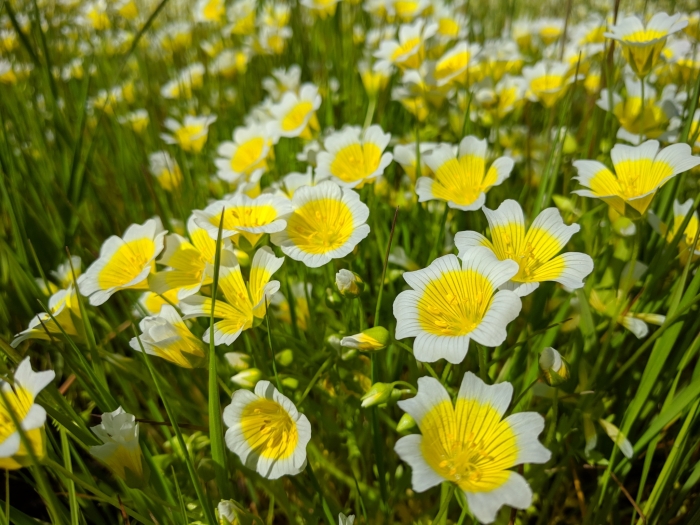Douglas’ Meadowfoam
(Limnanthes douglasii)
Douglas’ Meadowfoam (Limnanthes douglasii)
/
/

Ken-ichi Ueda
CC BY 4.0
Image By:
Ken-ichi Ueda
Recorded By:
Copyright:
CC BY 4.0
Copyright Notice:
Photo by: Ken-ichi Ueda | License Type: CC BY 4.0 | License URL: http://creativecommons.org/licenses/by/4.0/ | Rights Holder: Ken-ichi Ueda | Publisher: iNaturalist | Date Created: 2018-03-31T11:34:03-07:00 |





















































Estimated Native Range
Summary
Limnanthes douglasii, commonly known as Douglas’ Meadowfoam, is an annual herb native to vernal pools, wet grasslands, and the edges of seasonal wetlands in California and Oregon. It reaches a modest height and width of 0.5-1 feet (0.2-0.3 meters), forming a low, spreading mound. Douglas’ Meadowfoam is characterized by its attractive yellow and white flowers that bloom prolifically in the spring and early summer, with peak flowering typically occurring from April to June. The flowers are reminiscent of poached eggs, featuring white petals with bright yellow centers, contributing to its common nickname "poached egg plant." The plant’s foliage is also noteworthy, with bright green, fern-like leaves that add texture to garden settings.
Douglas’ Meadowfoam is valued for its ease of maintenance and its ability to attract beneficial insects such as hoverflies and bees, which are essential for pollination. It is often used in wildflower meadows, borders, and as a ground cover, especially in areas mimicking its natural wetland habitat. It thrives in full sun to part shade and prefers moist, well-drained soils, although it can tolerate a range of soil conditions. While it is self-seeding and can naturalize in a garden setting, care should be taken to manage its spread, as it can be potentially invasive outside its native range. Gardeners should consult local guidelines before planting to prevent ecological imbalances.CC BY-SA 4.0
Douglas’ Meadowfoam is valued for its ease of maintenance and its ability to attract beneficial insects such as hoverflies and bees, which are essential for pollination. It is often used in wildflower meadows, borders, and as a ground cover, especially in areas mimicking its natural wetland habitat. It thrives in full sun to part shade and prefers moist, well-drained soils, although it can tolerate a range of soil conditions. While it is self-seeding and can naturalize in a garden setting, care should be taken to manage its spread, as it can be potentially invasive outside its native range. Gardeners should consult local guidelines before planting to prevent ecological imbalances.CC BY-SA 4.0
Plant Description
- Plant Type: Herb
- Height: 0.5-1 feet
- Width: 0.5-1 feet
- Growth Rate: Moderate
- Flower Color: Yellow, White
- Flowering Season: Fall, Spring, Summer
- Leaf Retention:
Growth Requirements
- Sun: Full Sun, Part Shade
- Water: Medium
- Drainage: Slow, Medium, Fast
Common Uses
Bee Garden, Border Plant, Butterfly Garden, Groundcover, Low Maintenance, Potted Plant, Showy Flowers
Natural Habitat
Vernal pools, wet grasslands, and the edges of seasonal wetlands in California and Oregon
Other Names
Common Names: Poached Egg Plant, Geelwitte Moerasbloem, Sumpört
Scientific Names: , Limnanthes douglasii, Limnanthes douglasii var. nivea, Limnanthes douglasii var. douglasii, Limnanthes douglasii var. sulphurea, Limnanthus douglasii,
GBIF Accepted Name: Limnanthes douglasii R.Br.